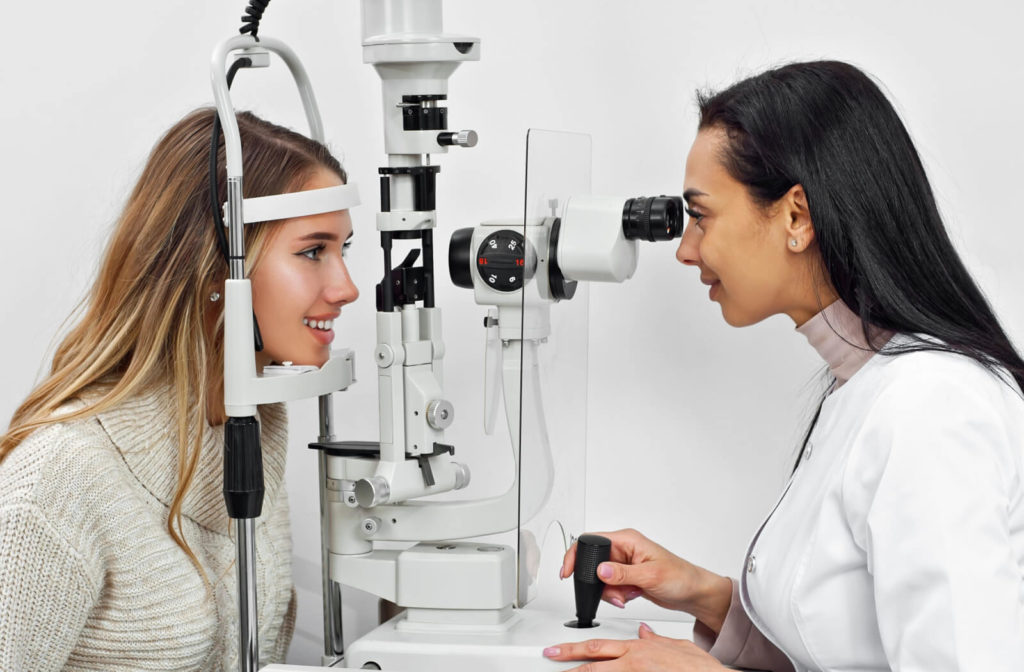Myopia (nearsightedness) and hyperopia (farsightedness) are both refractive errors that can impact our daily lives, affecting how we see the world around us. However, while they’re both refractive errors, they are not the same.
In a nutshell, myopia is a vision condition that causes blurry distance vision, and hyperopia is the opposite—it causes blurry vision close up. Their underlying causes are similar, but their effects on your vision differ.
Both myopia and hyperopia can significantly impact an individual’s ability to see clearly. Understanding the differences between them is crucial for proper eye care. If you believe your family’s vision might be affected by either of these conditions, speaking with an eye doctor and getting an eye exam can be great opportunities to learn more.
What Is Myopia?
Myopia, also known as nearsightedness, is a refractive error in which your eyes can’t focus on objects in the distance. People with myopia can see nearby objects clearly, but distant objects often appear blurry.
Myopia develops when your eyeball is too long or your cornea or lens is shaped too steeply. Genetics often play a role in the development of myopia, and it usually emerges during childhood or adolescence.
What Is Hyperopia?
Hyperopia, also known as farsightedness, is a refractive error that affects close-up vision. People with hyperopia can often see objects in the distance clearly, but nearby objects appear blurry.
Hyperopia occurs when your eyeball is too short or your cornea or lens is not curved enough. Unlike myopia, hyperopia may not present symptoms until later in life. It can affect people of all ages, and it can be difficult to diagnose for children with basic vision screenings provided at school—kids with hyperopia may be able to read clearly at a distance and might not realize their blurry close-up vision can be corrected.
Key Differences Between Hyperopia & Myopia
Some of the key differences between nearsightedness and farsightedness include the following details:
- Light focuses at different points. A primary distinction between myopia and hyperopia lies in the focusing point of light. In myopia, light focuses in front of the retina, whereas in hyperopia, it focuses behind the retina.
- Your vision is blurred at different distances. Myopia causes distant objects to appear blurry, while hyperopia affects close-up vision.
- Myopia and hyperopia are related to different changes in eye anatomy. Myopia is often associated with an elongated eyeball, while hyperopia is linked to a shorter eyeball.
What Are the Signs of Myopia & Hyperopia?
Both myopia and hyperopia can cause blurry vision, although at different distances. However, they also share a few common symptoms that may be signs of an issue with vision for children, such as:
- Headaches
- Squinting
- Eye strain
Vision challenges may cause other new behaviors too, such as watching screens too close or pushing them further away. Looking for changes in behavior related to vision use can help you spot early signs of myopia and hyperopia.
How Can Myopia & Hyperopia Be Treated?
Some of the most common treatments for myopia and hyperopia are eyeglasses, contact lenses, and refractive surgery. Eyeglasses and contact lenses work by changing how light enters the eye, allowing for clear vision. Refractive surgery (laser eye surgery), such as LASIK, can help correct these conditions by reshaping the cornea.
Myopia Control
Corrective measures for myopia typically include eyeglasses or contact lenses. However, in recent years, orthokeratology (corneal reshaping lenses) and other techniques for myopia control have also become popular.
Myopia control can help kids with myopia stop their vision from getting worse over time. There are several options for myopia control, including specialty contact lenses, so we can tailor a myopia control plan to your child’s unique needs.
Which is More Prevalent, Myopia or Hyperopia?
Hyperopia is generally considered to be less common than myopia. According to recent studies, the number of nearsighted people has been rising globally. It’s estimated that half of the world’s population could be nearsighted by 2050. The National Eye Institute estimates that over 40% of Americans are affected by myopia. Hyperopia, on the other hand, affects around 5–10% of Americans.
Prevention & Management of Myopia & Hyperopia
While myopia and hyperopia have strong genetic risk factors, there is ongoing research into certain habits that may be contributing to their development too.
Myopia in particular is the subject of research surrounding screen use and time spent outdoors as possible factors that can affect a child’s developmental risk. In some cases, getting regular outdoor time, getting regular eye exams, and avoiding prolonged use of electronic devices may help prevent or manage these conditions.

Get Support for Myopia & Hyperopia
Myopia and hyperopia can be corrected using glasses, contact lenses, and refractive surgery, depending on your age and personal health. It’s important to undergo routine eye exams to monitor your eye health and find the right form of treatment for your needs.
Remember to take good care of your eyes, and always consult an optometrist or eye care professional if you experience any vision changes or problems. Dr. Taylor Bladh, O.D. and the rest of our team are ready to help you see clearly. Contact us today to book your next appointment!



